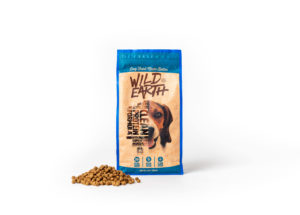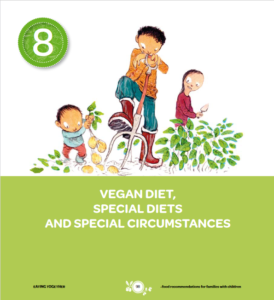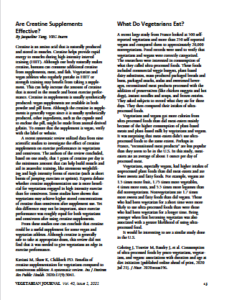PERSPECTIVE OF A DIETETIC INTERN: 12 YEARS OF VEGETARIAN NUTRITION AND CHANGES IN PROFESSIONAL RECOMMENDATIONS 0
We asked Cierra Peterlin, a dietetic intern from the University of Maryland dietetic internship program who is with The Vegetarian Resource Group for 4 days to spend at least 4-6 hours reviewing the VRG website, back issues of Vegetarian Journal/Vegan Journal (available on the website), and the Academy of Nutrition and Dietetics (formerly known as the American Dietetic Association)’s current and earlier position papers on vegetarian diets. After that, we asked Cierra to write about what she found especially interesting and why and what she’d like to learn more about. Here’s what she said.
To begin this write-up, I would like to describe what I learned and found interesting in the 3 ADA/AND position papers addressing vegetarian diets (1-3). I found it very interesting to read through these 3 papers consecutively and be able to compare different statistics and statements made over the course of the 12 years between publishing. While I had been aware of the increase in people following vegetarian diets in the US, it was really encouraging to see this on paper and see the actual statistics around the increase. The three papers each documented the percentage of US adults who were vegetarian stating that in 2000 2.5% of US adults were vegetarian and by 2016 3.3% were (1,3). In terms of protein, each paper described how complementary proteins did not need to be consumed in the same meal and that a diet with various plant-based protein sources would meet adequate protein needs over the course of a day (1-3). I think this is an important point to address because many people, health professionals and everyday vegetarians alike, are still in the mindset that protein combining is necessary at each meal. In the 2016 paper, the words complete and incomplete protein were used to debunk the misconception that complete proteins are more adequate from a dietary perspective (3). I was not aware that wheat protein may only be about 50% as available as other sources of protein such as soy or animal proteins (1). In the 2009 paper the Academy mentioned that nutrition professionals should be aware that depending on food choices, needs for protein may be higher in vegetarians (2).
I hadn’t previously realized that non-heme iron was more susceptible to inhibitors as well as enhancers than compared to heme iron. In the 2003 paper, it was stated that vegetarians have iron needs that are 1.8x greater than those of nonvegetarians due to lower bioavailability of non-heme iron; however, in the consecutive two papers, an exact amount of increased need was not given (1-3). The mechanism of decreased iron needs related to a physiological adaptation to lower iron intake was described in all three papers suggesting that some vegetarians may have significantly lower needs than others in terms of their bodily adaptations and ability to absorb iron more or less readily (1-3). Zinc was also noted to be physiologically adaptive to lower intakes and susceptible to certain inhibitors of absorption as well (1-3). I learned how the conversion of n-3 fatty acids to DHA and EPA is inhibited when n-6 fatty acid consumption is higher and vice-versa (2). Within the three papers I also liked how the vitamin D subsection was expanded upon in each consecutive paper. In the first paper, vitamin D-3 was described as being strictly derived from animal products and being the more bioavailable source beyond low dose supplementation. In the 2009 paper the difference between vitamin D3 and D2 was described, and it was stated in the 2016 paper that vitamin D3 can be derived from plant sources and provide the same bioavailability in supplements (1-3).
I found it interesting that iodine was recommended as a supplement for women of childbearing age in the 2016 paper only and how different aspects of vegetarianism during pregnancy were built upon substantially from the 2003 paper and on (3). In all papers, infants who are not breastfeed are recommended to consume soy infant formula if following a vegetarian diet as well as pregnant and lactating mothers making sure to consume adequate food sources or to supplement with folic acid, vitamin D, iron, and vitamin B12, as well as consideration of an omega-3 fatty acid supplement (1-3). Maternal weight gain and risk of gestational diabetes was mentioned only in the 2016 paper as well as risk of childhood and adolescent overweight and obesity risk; both reduced by vegetarian diets (3). Consistently in all three papers, the idea that a vegetarian diet can establish lifelong healthy eating habits in children was conveyed.
In the 2003 paper, the ADA mentioned how traditionally scientific articles about vegetarian diets questioned the adequacy of the diet but more recently the research published had been suggesting vegetarian diets were a way to prevent and treat certain diseases. In terms of disease prevention and treatment, position paper 1 of 2003 presented the research supporting an overall lower BMI in vegetarian subjects which was then stated more directly in the 2016 paper that obesity risk can be reduced by vegetarian diets and to make nutrition professionals aware of this treatment option for overweight and obesity (1,3). The other disease state that I am interested in mentioning in this write-up is diabetes: The 2003 paper supported vegetarian diets as able to meet treatment guidelines for diabetes as well as be able to reduce the risk of developing type 2 diabetes (1). The 2009 paper dove deeper into specific research that supported an increase in consumption of plant foods, especially legumes, can lead to greater glycemic control in the treatment and prevention of diabetes (2). Lastly, the 2016 paper reported that vegetarian diets can lower risk of developing diabetes as well as be used as therapy to manage diabetes when there is emphasis placed on nutrient-dense, high fiber foods (3).
In the evolution of the position of the AND on vegetarian diets, the most recent paper also addressed the environment and the environmental sustainability of vegetarian and vegan diets. Whereas in the previous 2 papers, human health was the only topic addressed, the 2016 paper briefly discussed some environmental impacts of consuming vegetarian and vegan meal patterns as compared to diets containing meat. The future of our environment is something I care deeply about and so do many people interested in following a plant-based diet. I think addressing the environment in this paper is very important because it brings in another piece to the puzzle as well as a pull from a different string for support and adherence to a plant-based diet.
While I could write more about various other points I drew from the 3 position papers, to keep this write-up closer to two pages I am going to now discuss what I discovered and what piqued my interests while exploring the VRG website and the archives of the Vegan Journal and Vegetarian Journal.
I found exploring the VRG website and the archives of the Journal so inspirational and informative. There is so much to read and discover on this site and I definitely will spend my free time in the future continuing to dive into the group’s articles and archives as I feel that I’ve barely scratched the surface of what it has to offer. I started my search by looking into the history of VRG and the work that has been done and is ongoing. I read about the first publication of the Vegetarian Journal and the initial projects of the group. Reading of the cooking demos, school talks, community events, donation efforts, fundraising events, group trips, and outreach was inspirational and gave me so many ideas of things I would love to be a part of in the future. I was especially interested in the work that has been done with educating educators such as health professionals and teachers about vegetarian nutrition and the impacts it has on human health and environmental health. I liked the article that brought vegetarianism to the forefront of environmental issues that addressed the Chesapeake Bay and the pollution facing that natural space. The reporter on the issue mentioned the effects of land use and animal pollution and how choosing to eat vegetarian may be a helpful factor in preserving our natural lands. I liked reading about the projects where VRG had booths at medical conferences and how they worked with foodservice establishments to increase availability of vegetarian options in schools and other settings. Coming off of a rotation with the USDA, I realize how many students rely on the National School Lunch Program for their meals and believe that the option of a vegetarian/vegan meal should be given at every meal and in every setting that provides free meals. I am interested in this issue and how to best enact change and work toward more diverse and healthful meals in schools that provide food to students. I also loved reading about VRG’s work in schools and would love to see the I Love Animals and Broccoli coloring book!
The last point I will bring up in this write-up is the completeness and comprehensiveness of the various guides on vrg.org. The vegetarian guide to food ingredients is so full of information on pretty much every common ingredient in foods. I had previously used vrg.org to look up certain ingredients for my own sake but looking at all the ingredients in that guide was so eye-opening. I have not yet read through all of the ingredients listed but I plan to and hope to have this as a tool to use in my personal life as well as in future practice as an RDN providing nutrition education and working with clients and groups. The other guide I was particularly struck by was the restaurant guide! This was so vast and such a wonderful resource for anyone looking to eat plant-based while dining out. The compilation of options in every state and city is so amazing. Another list was the lists of vegan businesses which goes way beyond just products but even into services and travel accommodations and is something that I will refer back to as well! the various resources on the webpage are also something I loved viewing. It made me think of how I can use them in future practice when working with people interested in a vegetarian or vegan diet.
References
- American Dietetic Association; Dietitians of Canada. Position of the American Dietetic Association and Dietitians of Canada: Vegetarian diets. J Am Diet Assoc. 2003;103(6):748-765.
- Craig WJ, Mangels AR; American Dietetic Association. Position of the American Dietetic Association: vegetarian diets. J Am Diet Assoc. 2009;109(7):1266-1282.
- Melina V, Craig W, Levin S. Position of the Academy of Nutrition and Dietetics: Vegetarian Diets. J Acad Nutr Diet. 2016;116(12):1970-1980.










